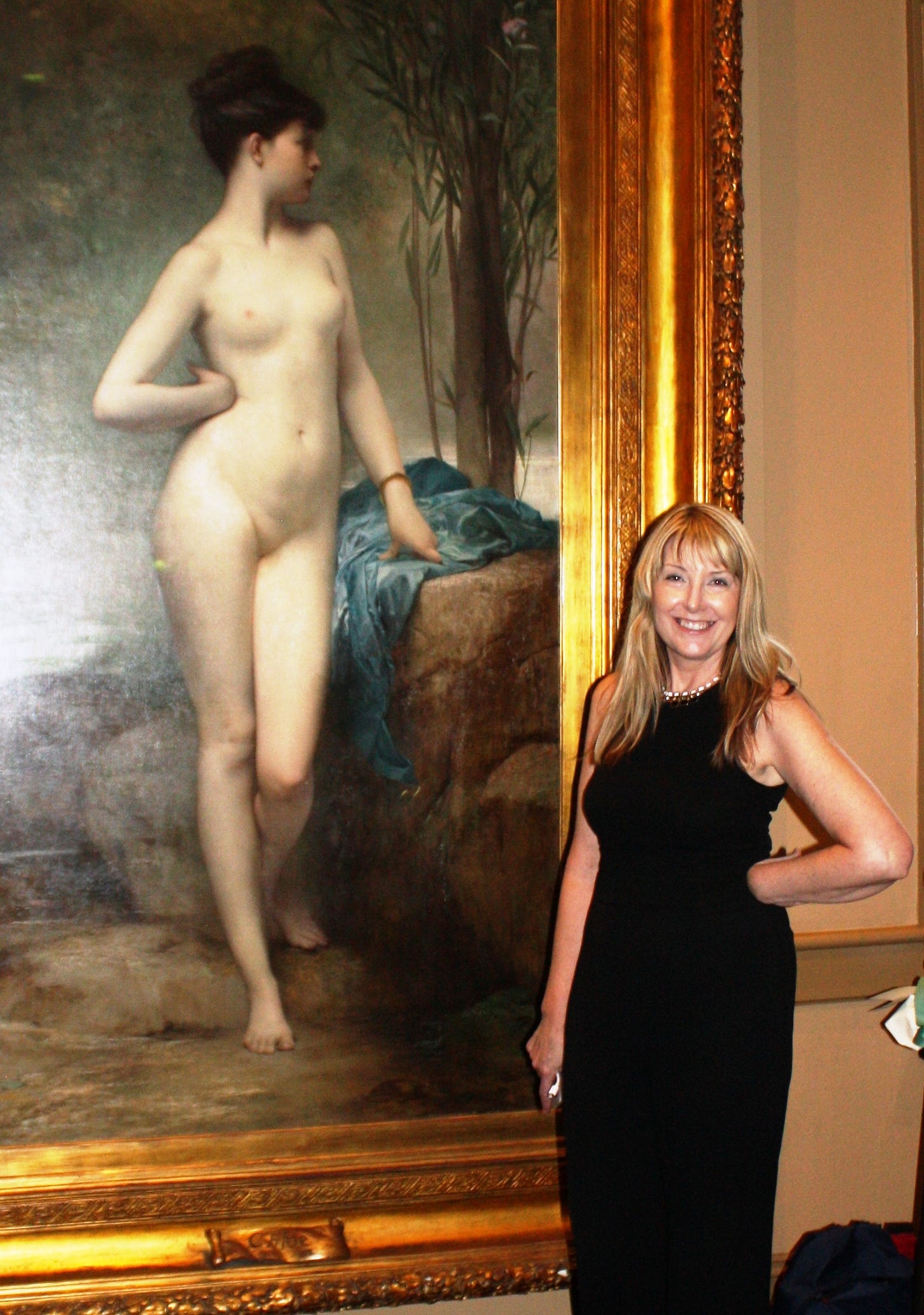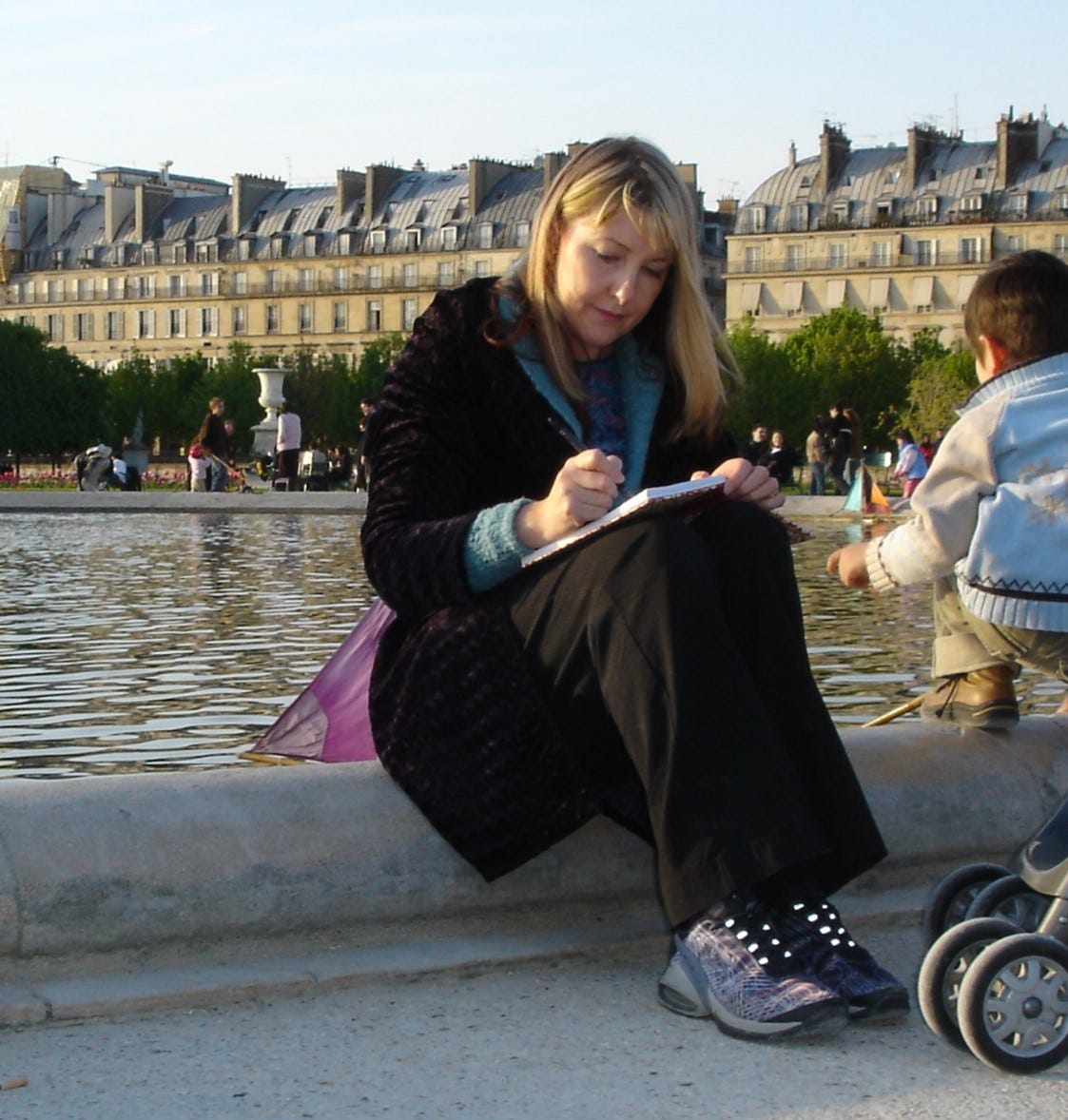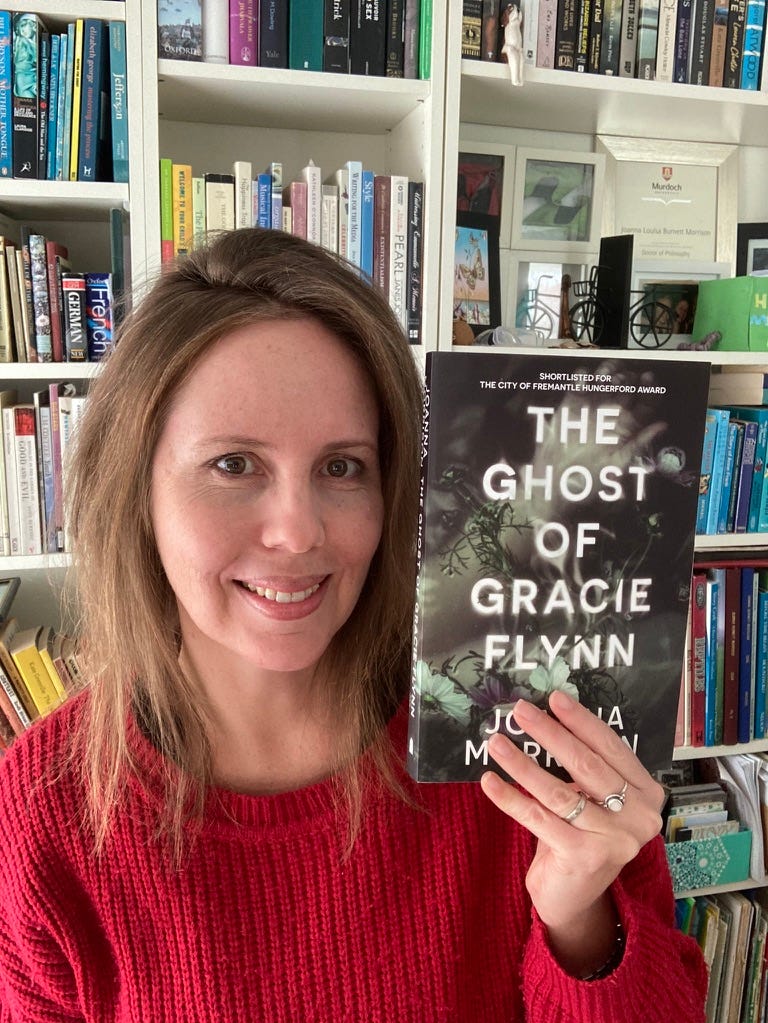A Parisienne nude, an Australian novelist, and a fateful lucid dream
An interview with Katrina Kell about her latest novel, 'Chloé'
Welcome back to Thursdays After Lunch! This week, I’m excited to bring you my first Substack interview, featuring West Australian author Katrina Kell and her latest novel, Chloé (Echo Publishing, 2024).
Chloé reimagines the life of a French model who posed for an iconic painting—also titled Chloé—which has hung in Melbourne’s Young and Jackson Hotel since 1909. Painted in Paris in the late 1800s, Chloé stirred up her fair share of controversy when she first arrived in Australia. She also came to symbolise hope and home for many Australian soldiers amidst the horrors of a world at war.
I first met Katrina some years ago, when both of us were working on our creative writing PhDs. In one of our first conversations, in the car park beneath towering Eucalypts on campus, Katrina told me all about Chloé. I remember being struck by what a fabulous idea it was to write a novel about such a beautiful, mysterious painting. Since then, Katrina and I have shared many of the highs and lows of our writing journeys, and read each other’s work back and forth, so it’s such a thrill to see Chloé released into the world this month.
Blurb:
A riveting novel based on the true story of the brave, enigmatic young woman who modelled for one of Australia’s most famous paintings.
Taking the reader from Victoria’s wild shipwreck coast to the artists’ studios of revolutionary Paris and the bloody battlefields of Flanders, this sweeping novel reimagines the volatile history of the beautiful and enigmatic young woman immortalised in one of Australia’s most iconic paintings. Created in Paris in 1875, Chloé, Jules Lefebvre’s depiction of a naked water nymph, was brought to Melbourne’s Young & Jackson Hotel in 1909, where it has hung ever since.
In this passionate, luminous retelling, Katrina Kell seeks to unlock the riddle behind the girl on the canvas, known to history only as Marie. In doing so, she weaves the compelling story of an incandescent spirit – a woman with the strength to defy the boundaries of class and convention in order to survive, and an enduring power to influence the lives of others across time and distance.
Chloé’s Melbourne launch has been and gone, but the Perth launch is next week: Tuesday, 26th March, 6pm-7.30pm. Book your free ticket here.
Interview
Welcome Katrina, and congratulations on the publication of Chloé! Can you remember where you were and what you were doing when you had the idea for this novel?
I was inspired by a lucid dream, a dream that stayed with me long after waking.
In the dream, I was seated in a comfortable chair reading an antiquarian novel, an elegant, somewhat hefty volume replete with full cloth binding and gold lettering on the spine and cover. The book was called Chloe’s Child and my name was on the front cover. In the midst of the dream, I found myself questioning the novel’s title. Who was the eponymous Chloé, and why had I written her story? Before I could solve the puzzle, a white cockatoo alighted on the book, and a tangled forest sprang up around me.
The dream left me with a strong sense of unfinished business, and the following morning, two words continued to haunt me — “Chloé” and “cockatoo”. There were no women in my life named Chloé. However, the white cockatoo that disrupted my dream and its Antipodean symbolism seemed to imply she may be Australian. That’s when memories began to resurface about a famous nude painting in a pub in Melbourne. After a quick search on the internet, I found an image of Chloé on the Young Jackson Hotel website. Enlarging the picture on my screen, I studied the young model’s profile—her troubled eye, that forlorn expression—and I was already reimagining her story
I love that she came to you in a dream. Can you tell us a bit about the painting’s history?
Chloé was created in the Paris winter of 1874/75 by the celebrated artist Jules Joseph Lefebvre. The painting debuted at the 1875 Paris Salon (an annual state-sponsored exhibition at the Grand Palais des Champs-Elysees) and was unveiled in the Australian colonies at the Sydney International Exhibition of 1879 and the 1880 Melbourne International Exhibition. Nearly 1.5 million people attended the Melbourne exhibition, far exceeding Victoria's population at the time.
After the exhibition closed, the eminent surgeon and art collector Dr Thomas Fitzgerald purchased Chloé. In 1883, he loaned the painting to the National Gallery of Victoria (NGV). But when the NGV opened its doors on Sundays, a passionate debate erupted in the press over the propriety of displaying a French nude on the Sabbath. Frustrated by all the fuss, Fitzgerald withdrew the painting and sent Chloé to the Adelaide Picture Gallery for a relatively uneventful three-year period. But later, when he hung Chloé at his home in Melbourne, where the nude was visible to passing pedestrians, another public outcry erupted. Removed from the public gaze, Chloé remained in obscurity until after Fitzgerald’s death, when entrepreneurial publican Henry Figsby Young paid 800 pounds for Chloé and hung her in the saloon bar of Young and Jackson Hotel in Melbourne as ‘an added attraction.’
Eight decades later, Chloé was so synonymous with the famous hotel that an amendment was applied to the Victorian Heritage Register of Historic Buildings to include "the painting 'Chloé' by Jules Lefebvre":
The hotel is historically significant for the public display of the painting Chloé since 1908 [sic]. Chloé not only helped to promote the hotel but also came to symbolise popular resistance to conservative Victorian values.1
Without giving away any spoilers, can you tell us anything about the model who posed for Chloé?
In his memoir Confessions of a Young Man (1888), the Anglo-Irish writer George Moore (1852-1933) shared his memories of the artist model he claimed was ‘Lefebvre’s Chloé.’ Her name was Marie, and according to Moore, she was beautiful, feisty, and elegant. Jules Lefebvre also shared his thoughts about Chloé’s model in an 1876 interview with the American journalist Lucy Hamilton Hooper. Lefebvre claimed ‘she was a girl of more refinement and elevation of sentiment than is usually to be found among persons of her position,’ which seems to imply his model was working class. He also claimed she was entangled with a gang of ‘low confederates,’ which, of course, immediately ignited my imagination.
I’d love to know more about the importance of Chloé to Australian soldiers in Melbourne, and the tradition of having a drink with her before heading off to war.
The ritual of Australian soldiers ‘having a drink with Chloé’ began in WWI and continued over ensuing decades. Young and Jackson Hotel and its world-famous painting proved irresistible for men and boys leaving and returning from military conflicts.
By the commencement of WW2, Chloé and Young and Jackson Hotel were so embedded in Australian military mythology, the 2/21st Australian Infantry Battalion included them in their official march song:
Good-by Young and Jackson’s
Farewell Chloe too
It’s a long way to Bonegilla
But we’ll get there on STEW2
In 1945, West Australian traveller Peter Graeme compared Chloe’s iconic status to the Sydney Harbour Bridge:
“. . . from the soldier’s point of view of course . . . All over Australia you meet men who have seen her. She is a soldier’s pilgrimage when in Melbourne. . . Chloe belongs to the Australian soldier.”
One day, he met a soldier at Young and Jackson Hotel. The soldier carried three drinks over to Chloé and drank them in front of her. When Graeme asked the man why he had drunk three beers in quick succession, the soldier explained he was keeping a promise:
“Keepin’ a promise we made to Chloe—three of us—twelve months ago when we were goin’ North—to have a drink with her when we came back.”
He paused. “Here’s the best,” he said, and I nodded in agreement.
“Where’s your mates?” I asked.
He was looking at Chloe as he answered, as though explaining their absence.
“I buried ’em at Scarlet [sic] Beach.”
As Graeme concluded in his poignant tale, Chloé may have been ‘the symbol of the feminine side of his life. That part which he puts away from him, except in his inarticulate dreams.’3
I can see why it was so important to you to include Australian soldiers in the novel. You wrote Chloé as part of a Creative Writing PhD. How do you think that process influenced the novel as it is today?
The PhD gave me the luxury of time and mental space to immerse myself fully in Chloé’s history and to reimagine my findings creatively. It also enabled me to visit the Australian War Memorial archives in Canberra and do archival and field research in Paris and the Somme region in France. Descending into the claustrophobic world of the 1916 Trench Museum in Albert, walking the same cobbled streets that Chloé’s model would have travelled, and vicariously recreating her lived experiences contributed enormously to the novel’s development.
In terms of the creative decisions you’ve had to make in the crafting of this book, can you think of one that was the most difficult to make?
There were so many creative decisions that influenced the novel Chloé is today. But settling on an effective structure for the book was definitely the most challenging. The story spans different continents, wars and time periods, so deciding on ways to weave these threads together was often tricky. It was a deeply intuitive process, one where I had to trust my instincts, and after much to-ing and fro-ing, I settled on the structure I had originally imagined for the novel.
You’ve published two novels before now, both of them YA books: Juice (Fremantle Press, 2000) and Mama’s Trippin (Fremantle Press, 2006). Did it feel very different this time around, writing an adult historical novel?
That's such an interesting question. To be honest, if didn't feel different. I'm a ‘panster’ when it comes to my novels. When I'm deeply immersed in the writing process, the story and its characters take on a life of their own. So whether it's an adult novel, YA fiction, short fiction, or even poetry, I am always guided by my imagination. There is a fascinating phenomenon – The Illusion of Independent Agency (IIA)– which I discuss in my PhD thesis, which goes some way to explaining my writing experience. It's when a fiction writer feels like their characters have hijacked their story, something I often experience. Alice Walker, George Saunders, and others have shared their experiences of IIA, so it would be fascinating to know how many writers experience this phenomenon.
Katrina, every time we catch up, I learn something new and fascinating about your life and the cool things you’ve done. You’ve been a journo, you’ve raised four kids, you’re a grandmother, you’re married to a muso, you’re well-travelled, you were born in Scotland, you’ve coached Little Athletics … the list goes on. But one of my favourite details is that you used to own a travelling bookshop. Can you tell us how this came about, how long it lasted, and whether you miss owning a bookshop on wheels?
The bookshops were jointly owned with my then-husband, Neil Watson. Our first bookshop, A Touch of Strange, specialised in Fantasy and Science Fiction. We had a stunning ceiling mural, complete with planets, stars, moons, and even a wonky attempt at a 'black hole,' which our customers suspected was a leak in the ceiling! After a few years, we sold A Touch of Strange and transitioned to a mobile bookshop. The Book Bus sold directly to schools, public libraries, and universities, and our motto was Reading for Pleasure! They were fun and exciting days, and I loved the relationships and friendships I made with many librarians. So, yes, I miss owning a bookshop on wheels and all the fabulous books I had at my fingertips.
Sounds like a lot of fun. A lot of hard work too, no doubt. Finally Katrina, where can readers find you online?
If readers are interested, they can find me on my website: katrinakell.com, on Instagram @katykell2019, or as KatrinaKellWriter on Facebook.
About Katrina Kell
Katrina lives and works on the unceded lands of the Whadjuk Noongar people in Western Australia. Her short stories, poetry and essays have been published in anthologies and literary journals including Westerly, Text, Raudem and Index, and her journalism has appeared in various media, including The Conversation. She is the author of two young adult novels, Juice and Mama’s Trippin’, and was the winner of an Australian Society of Authors Award Mentorship for the unpublished manuscript of Chloé. Her PhD thesis, Capturing Chloé: Reimagining a Melbourne Icon, explores the myths and volatile history of the iconic nude painting and its model.
That’s all for this week. Feel free (literally) to subscribe below for more writing updates, bite-sized reviews, tips and author interviews!
Until next time,
Joanna
My name is Joanna Morrison. My debut novel, ‘The Ghost of Gracie Flynn’, is an atmospheric mystery novel in which three university friends are divided by a tragic death. Eighteen years on, they’re reunited, but when another body is found, the ghost of Gracie Flynn has a story to tell about the night that changed their lives forever.
Australia, Victorian Heritage Register, 1989
““It’s a Long Way to Bonegilla:” Big March To-Day.” September 23, 1940. Trove.
Graeme, Peter. “Seein’ Chloe.” Western Mail, May 3, 1945. Trove.









